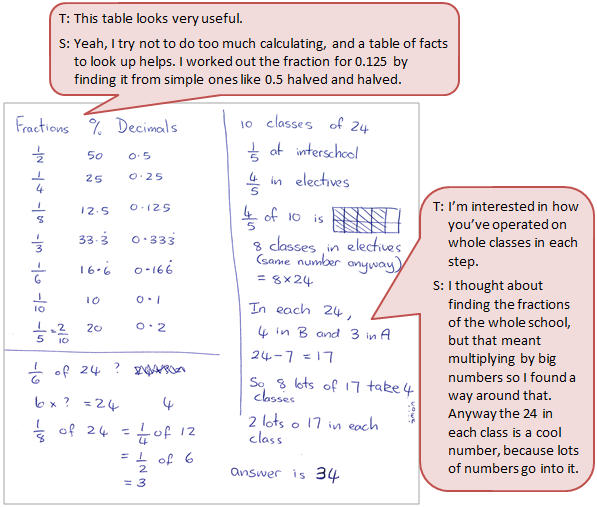The purpose of this activity is to engage students in working with common fractions, decimals and percentages interchangeably, to solve a problem.
This activity assumes the students have experience in the following areas:
- Working with the place value of whole numbers and decimals, including multiplying and dividing by ten.
- Finding equivalent fractions.
- Calculating fractions of an amount, and percentages of an amount.
- Converting between fractions, decimals, and percentages.
The problem is sufficiently open ended to allow the students freedom of choice in their approach. It may be scaffolded with guidance that leads to a solution, and/or the students might be given the opportunity to solve the problem independently.
The example responses at the end of the resource give an indication of the kind of response to expect from students who approach the problem in particular ways.

An intermediate school has ten classes with 24 students in each.
Instead of regular classes, it is offering 6 ‘electives’ for a week when 20% of the students will be away for an interschool sports exchange.
0.125 of the students who will remain at school, have chosen to take elective A.
One sixth chose elective B.
The rest of the students all chose the four electives, C, D, E and F in an exactly even split.
How many students can the teachers taking C expect in their elective?
The following prompts illustrate how this activity can be structured around the phases of the Mathematics Investigation Cycle.
Make sense
Introduce the problem. Allow students time to read it and discuss in pairs or small groups.
- Do I understand the situation and the information? (Students may need support to understand the situation. They need to recognise that 20% of the 240 students in total are going to interschool sport. The fractions are calculated on the remaining number of students.)
- What are the important numbers in the problem? (Readily converting decimals to fraction and vice versa is useful in solving the problem, e.g., 0/125 = 1/8)
- What will my solution look like? (The solution will say how many students are in Elective C. It will also show how the answer was obtained.)
Plan approach
Discuss ideas about how to solve the problem. Emphasise that, in the planning phase, you want students to say how they would solve the problem, not to actually solve it.
- What math skills will I need? (Students should recognise that they will need to find fractions of amounts and subtract whole numbers.)
- How will I organise my working out, so I answer the problem in a systematic way, and not miss anything?
- What representations will be helpful? A diagram? Equations? A table?
- What tools (digital or physical) could help my investigation? (A calculator is not essential but will ease the calculation burden.)
Take action
Allow students time to work through their strategy and find a solution to the problem.
- Have I shown my workings in a systematic way?
- Have I used all the information in the problem?
- Do my operations make sense? Do they match the conditions of the problem?
- Did I notice any relationships among the numbers that could be helpful?
- Does my answer seem correct? Does it seem reasonable?
Convince yourself and others
Allow students time to check their answers and then either have them pair share with other groups or ask for volunteers to share their solution with the class.
- What is the solution? Does it give the number of students in Elective C?
- Is my working clear for someone else to follow?
- Do I justify each step of my working? How?
- Could I have solved the problem in a more efficient way? How?
- What maths have I used?
- How might I use what I learned on this problem to solve other problems?
Examples of work
Work sample 1
The student solves a problem involving decimals, percentages, and fractions, with guidance.
Click on the image to enlarge it. Click again to close.
Work sample 2
The student uses numerical strategies to solve a problem involving decimals, percentages, and fractions independently.
Click on the image to enlarge it. Click again to close.
Work sample 3
The student combines graphic representation and arithmetic strategies to solve a problem involving mixed decimals, percentages, and fractions independently.


